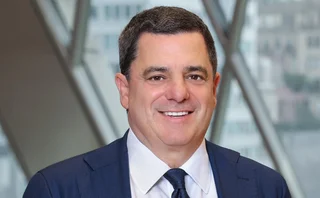
Deal of the year: Sempra LNG
Energy Risk Awards 2021: Groundbreaking LNG project in Mexico is only export facility to reach financial close amid tumult of 2020

Last year won’t be remembered as a banner one for energy infrastructure investment. The Covid pandemic and the subsequent collapse in energy prices brought most project development to a grinding halt. But of several natural gas liquefaction projects scrambling to reach financial close last year, one made it: the Energía Costa Azul (ECA) liquefied natural gas (LNG) export facility in Baja California, Mexico.
“The success of the development would have been remarkable in the best of times,” says Justin Bird, CEO of Sempra LNG. “It’s a tribute to the men and women of our company and of our partners what we were able to accomplish during the pandemic.”
The project – a joint venture between Sempra LNG, Mexican sister company IEnova and French oil major TotalEnergies – will have a capacity of three million tonnes of LNG per annum (Mtpa). In addition, an affiliate of TotalEnergies, together with Japanese trading house Mitsui, will offtake 2.5Mtpa under long-term, US-dollar-denominated, take-or-pay contracts. First LNG production is expected to occur as early as 2024.
The facility will enable the export of US natural gas to Asian markets, cutting transport times from around 21 days to just 11, bypassing the often-congested Panama Canal and thus dramatically reducing costs – and emissions. Bird notes that, while shipping costs for oil products equate to around 3% of the landed product, the figure is closer to 20% for LNG. “Shipping really does matter,” he says.
This export will support the region’s transition away from more carbon-intensive coal-fired power generation. “We think LNG will play an important role in the energy transition,” says Bird. “Renewable energy needs a base fuel to support it, because the wind doesn’t always blow and the sun doesn’t always shine … Natural gas can provide that baseload. We’re excited to be in that space.”
Meanwhile, securing financing – in this case, a five-year $1.6 billion project loan from a syndicate of nine international banks – was particularly challenging, given the effects of Covid lockdowns on energy markets.
Part of the solution involved Sempra LNG de-risking the project’s future revenue streams by developing a composite LNG pricing index that will reduce its exposure to basis risk – that is, the risk of mismatches between the price that it will pay for natural gas in US markets and the price it will receive from offtakers from the ECA terminal.
“We’re an infrastructure company at heart,” says Bird. “We like to minimise commodity exposure.”
Meanwhile, the partners had to ensure that the project met stringent environmental and social safeguards, even as these were changing. During the financing process, the banking sector updated the Equator Principles, which set rigorous standards for infrastructure projects.
“Our commitment to the environment is very strong – we’re very proud of the efforts we’ve made in relocating fauna and establishing programmes to protect sea animals,” says Bird, noting that the company has also relocated 20,000 endangered ferocactus, a barrel-shaped cactus native to the area.
Its social engagement also proved key, he adds, pointing to a long-term relationship between Sempra LNG and IEnova, which, for more than 15 years, has run a regasification terminal next to the planned liquefaction project.
“It really is part of the spirit of Sempra LNG to constructively engage with our stakeholders to find solutions and help them meet their needs,” says Bird.
In a public consultation exercise, 60% of those participating in a vote supported the new project. He credits an appreciation of the economic opportunities it will bring, as well as social investments over the years in the local community, including providing police vehicles and ambulances, improving schools and playgrounds.
That engagement also extended to the Mexican government, with which the partners had to work to establish a regulatory framework for the facility. “Given the nature of the project, Mexico didn’t have specific regulations in place,” says Bird. “We did a lot of work with the federal government, as well as with the local and state governments.”
Ultimately, the project partners were able to reach financial close, and work has begun on site preparation. “It’s a credit to that partnership and the team in Mexico,” he says. “But we also saw an outpouring of support from the broader LNG industry. Everyone was excited that we got this over the line – it has become a symbol for the industry that we were able to get this done in 2020.”
Only users who have a paid subscription or are part of a corporate subscription are able to print or copy content.
To access these options, along with all other subscription benefits, please contact info@risk.net or view our subscription options here: http://subscriptions.risk.net/subscribe
You are currently unable to print this content. Please contact info@risk.net to find out more.
You are currently unable to copy this content. Please contact info@risk.net to find out more.
Copyright Infopro Digital Limited. All rights reserved.
As outlined in our terms and conditions, https://www.infopro-digital.com/terms-and-conditions/subscriptions/ (point 2.4), printing is limited to a single copy.
If you would like to purchase additional rights please email info@risk.net
Copyright Infopro Digital Limited. All rights reserved.
You may share this content using our article tools. As outlined in our terms and conditions, https://www.infopro-digital.com/terms-and-conditions/subscriptions/ (clause 2.4), an Authorised User may only make one copy of the materials for their own personal use. You must also comply with the restrictions in clause 2.5.
If you would like to purchase additional rights please email info@risk.net
More on Awards
Market liquidity risk product of the year: Bloomberg
Bringing clarity and defensibility to liquidity risk in a fragmented fixed income market
FRTB (SA) product of the year: Bloomberg
A globally consistent and reliable regulatory standardised approach for FRTB
Best use of cloud: ActiveViam
Redefining high-performance risk analytics in the cloud
Best use of machine learning/AI: ActiveViam
Bringing machine intelligence to real-time risk analytics
Collateral management and optimisation product of the year: CloudMargin
Delivering the modern blueprint for enterprise collateral resilience
Flow market-maker of the year: Citadel Securities
Risk Awards 2026: No financing; no long-dated swaps? “No distractions,” says Esposito
Pricing and analytics: fixed income – Quantifi
Quantifi delivers high-performance, transparent and adaptable pricing and risk analytics for fixed income and credit markets
Derivatives house of the year: Citi
Risk Awards 2026: Rev up, RWAs down, as US bank gets back on track (with added XiNG and XiP)







